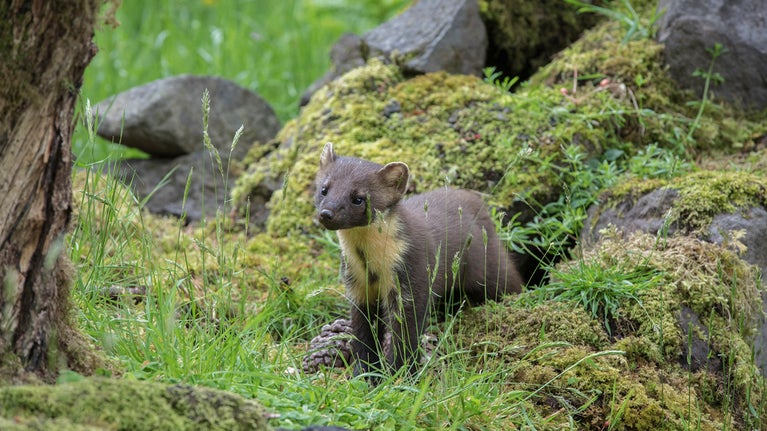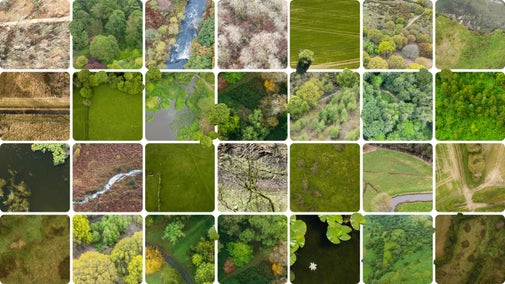Pine marten conservation at Wallington

The pine marten was once a familiar feature of English woodlands and plays an important role in keeping our woodlands healthy and balanced.
Here at Wallington we're working in partnership with Vincent Wildlife Trust on a pine marten conservation project, Martens on the Move, which aims to encourage the natural expansion of pine martens into the Wallington Estate. As one of three Pine Marten Haven sites across the country, our rangers and volunteers are working hard to ensure this species can thrive here.
The English and Scottish border area is one of Vincent Wildlife Trust’s strategic recovery areas, where previously reintroduced pine marten populations are now naturally expanding. Wallington has been selected as the English Pine Marten Haven site where visitors will be able to learn more about the species and the recovery work that is being done here.
Martens on the Move (which covers 11 counties in England, Scotland and Wales) is made possible with The National Lottery Heritage Fund. Thanks to National Lottery players, Vincent Wildlife Trust is able to bring together local landowners, land managers and communities to help native pine martens return to the forests of Britain.
What's a pine marten?
Pine martens belong to the weasel family and are one of 6 native mustelid species in Britain: badger; otter; stoat; weasel; polecat; pine marten.
Where do pine martens live?
Pine martens are woodland specialists and have excellent climbing skills that allow them to live in forested habitats. Pine martens naturally live at low densities and have large home ranges that don’t overlap with others of the same sex.
What do pine martens eat?
Pine martens are adaptive and opportunistic feeders that vary their diet throughout the year and take advantage of what is most locally abundant. This can include small mammals, particularly field voles, as well as invertebrates, birds, plants and fungi. In this way they help keep the forest ecosystem in balance.
How are we helping?
Wallington’s rangers and Martens on the Move are working with volunteers from West End Refugee Service, a charity supporting asylum seekers and refugees in Newcastle, to develop the Pine Marten Haven site and improve the woodland habitat.
We are so excited to be working in collaboration with our Haven partners. It means that we can offer so many more opportunities for people to learn about pine martens and how they can support their recovery. It also means that local community groups can get involved in hands-on habitat improvement work and monitoring in this joined up approach to pine marten conservation.

Pine martens and red squirrels
Alongside Wallington’s work on Martens on the Move, our red squirrel conservation project remains a top priority. It’s an ongoing challenge and, as with many of this country’s native species, they face a number of threats in addition to habitat loss. The primary threat to native red squirrels is the non-native invasive grey squirrel, which was introduced to Britian from North America in the 19th century. Grey squirrels outcompete native red squirrels for food and are carriers of the squirrel pox virus, which is harmless to greys, but deadly to our native reds.
Pine martens are carnivores and are known as ‘regulatory predators’, meaning they will eat whatever is in abundance. This increases the biodiversity of an area as it gives other species an opportunity to survive and thrive.
Red squirrels have co-evolved with pine martens and learned to fear them and keep out of their way. Studies in Britain and Ireland show that red squirrels only make up a small part of the animal's diet and in areas where pine martens are well established, there are reduced numbers of grey squirrels.
Although further research is needed to fully understand the dynamics between the three species, as the pine martens naturally recover at Wallington it's hoped that they'll help us to rebalance the scales and allow the red squirrels to flourish.
Vincent Wildlife Trust and Martens on the Move
You can find out more about Vincent Wildlife Trust and the Martens on the Move project, including details of the other Pine Matren Haven sites on the Martens on the Move website.
Our partners

A new era for pine marten conservation. Since 1983, Vincent Wildlife Trust has been working to conserve pine martens in Britain and Ireland. Pine martens are part of our rich wildlife heritage and play an important role in keeping our woodlands healthy and balanced.
You might also be interested in

Wallington
Discover Wallington, where a historical house meets rolling hills, woodlands and a walled garden.
Wilder Wallington – a place that works for people and nature
Wallington is going big! Wilder Wallington is a landscape-scale nature renewal project across the whole estate and beyond, aiming to capture carbon, reverse the decline in biodiversity and the impacts of climate change, and provide a place where nature and people to thrive together.

Beaver reintroduction at Wallington
Wallington has reintroduced beavers to the estate in an effort to renew and restore nature in the hope that they will help create a wildlife-rich wetland landscape. Over a year and a half after their release, find out what changes we have seen in the enclosure.

Red squirrel conservation at Wallington
The long-term recovery of red squirrels remains a top priority for us here at Wallington and is part of a wider nature recovery programme. Our rangers and volunteers work across the entire estate safeguarding and supporting the variety of native species that call this special place home; read about our red squirrel conservation programme.

Saving the native white-clawed crayfish
Find out more about our significant conservation project aimed at protecting the native white-clawed crayfish, now classified as endangered and at risk of extinction.

Adopt a Plot
Nature gives us life: through the supply of clean water, the pollination of our crops, the air that we breathe. But our islands are in danger and we’ve seen a higher depletion of nature here than almost anywhere else in the world. Adopt a Plot is a small way you can take a big step towards bringing back nature. From £7.50 a month, you can help renew a nature super site. These six sites, including Wallington, spread across the UK, have been specially selected for their potential to restore nature across whole landscapes. Find out more.